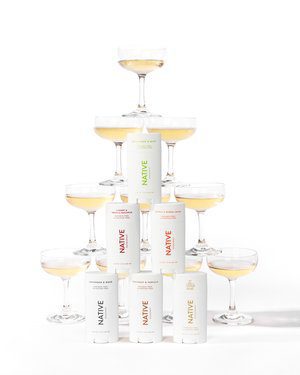Clean beauty products refer to skincare, haircare, and cosmetic items that are formulated with ingredients considered safe, non-toxic, and environmentally friendly. The clean beauty movement has gained significant popularity as consumers increasingly prioritize transparency, sustainability, and overall well-being.
Clean Beauty Market is valued at USD 6.46 Billion in 2021 and is expected to reach USD 15.29 Billion in 2028, growing at a CAGR of 13.1% from 2022 to 2028. –Brand Essence
The research consultancy Brandessence estimates that nearly one-third of the United States market is now labeled clean, with an increase of 12 percent expected from 2020 to 2027.
To better understand the definition of clean beauty products, let’s first take a look at leading clean beauty brands and clean beauty retailers’ definition and more in-depth analysis of this sector of the beauty industry,
Beautycounter’s definition of clean beauty products is outlined as:
At Beautycounter, we have something called The Never List: a collection of over 1,800 harmful or questionable ingredients we prohibit from our product formulations. Because clean peace of mind starts with transparency.
Beautycounter positions itself as a clean beauty brand, emphasizing the use of safer ingredients and advocating for more stringent regulations in the beauty industry. The company has a “Never List,” which is a list of more than 1,800 questionable or harmful chemicals that it pledges never to use in its products.
In addition to selling skincare and beauty products, Beautycounter has also been involved in advocacy efforts for cosmetic safety reform, aiming to raise awareness about the need for stricter regulations on ingredients used in personal care products.
Beautycounter’s THE NEVERLIST
Beautycounter’s THE NEVERLIST is an ingredient glossary that identifies harmful ingredients to avoid. This is a key resource to leverage when you’re trying to determine which products are truly clean. If a consumer purchases a fragrance, makeup or skincare product, they can refer to this list to identify if the ingredients are designated as clean or harmful.
Beautycounter is known for its advocacy efforts in the beauty and personal care industry. The company has been actively involved in promoting safer beauty standards and advocating for more stringent regulations on the ingredients used in cosmetic and skincare products. They are vocal in advocating for legislation change and they are a founding member of the Counteract Coalition, a group of like-minded companies and organizations working together to advocate for stronger federal regulations in the personal care product industry. The coalition aims to push for updated laws that prioritize consumer safety.
Consumers are obsessed with clean beauty products
Consumers are obsessed with clean beauty products because they align with values of transparency, health, sustainability, and ethical practices. The movement reflects a shift in consumer consciousness towards a more mindful and holistic approach to beauty and well-being.
Here’s why consumers are often obsessed with clean beauty products:
1. Transparency and Ingredient Awareness
Clean beauty products emphasize transparency in ingredient sourcing and formulation. Consumers are more informed and seek products with clear ingredient lists, avoiding potentially harmful chemicals.
2. Avoidance of Harmful Ingredients
Clean beauty products typically exclude ingredients that are perceived as harmful, such as parabens, sulfates, phthalates, synthetic fragrances, and certain preservatives. Consumers concerned about potential health risks are drawn to products without these additives.
3. Environmental Consciousness
Clean beauty often aligns with environmentally conscious practices. Brands committed to sustainability use eco-friendly packaging, responsibly sourced ingredients, and ethical production methods, resonating with consumers who prioritize eco-friendliness.
4. Health and Wellness Focus
The clean beauty movement is part of a broader health and wellness trend. Consumers view skincare and beauty routines as integral to overall well-being, leading them to seek products that contribute positively to their health.
5. Cruelty-Free and Vegan Options
Many clean beauty brands are committed to cruelty-free and vegan formulations. Consumers who prioritize ethical practices in animal testing and animal-derived ingredients are drawn to products that align with their values.
6. Holistic Approach to Beauty
Clean beauty goes beyond external appearance, emphasizing a holistic approach to beauty that considers overall health. Products often incorporate natural and botanical ingredients believed to offer benefits for both skin and well-being.
7. Allergen Sensitivity
Some consumers have sensitivities or allergies to certain synthetic ingredients commonly found in traditional beauty products. Clean beauty options often use gentler formulations, reducing the risk of irritation for those with sensitive skin.
8. Consumer Education and Empowerment
The clean beauty movement is accompanied by increased consumer education. Brands and influencers share information about ingredient benefits and potential risks, empowering consumers to make informed choices about the products they use.
9. Social Media Influence
Social media platforms play a significant role in promoting clean beauty products. Influencers and beauty experts often share their clean beauty routines, reviews, and recommendations, influencing consumer preferences.
10. Rise of Indie and Niche Brands
The clean beauty movement has seen the rise of indie and niche brands that focus on specialized formulations. Consumers appreciate the uniqueness and dedication to specific values offered by these brands.
11. Demand for Innovation
Clean beauty has driven innovation within the beauty industry. Brands are challenged to create effective formulations using natural and clean ingredients, leading to advancements in clean beauty technology.
12. Regulatory Advocacy
Advocacy for stricter regulations and transparency in the beauty industry has contributed to the clean beauty movement. Consumers support efforts to improve industry standards and prioritize their safety.
“Women are significantly more likely than men to search out clean beauty products – 36% of women report being ‘very interested’ in clean beauty, compared to just 18% of men. That said, there is still a market for clean products among men, given that a total of 41% say they are at least ‘somewhat interested.’”

Social Media and Clean Beauty
Retailers and brands contribute to defining clean beauty, but creators and influencers who categorize their content in this domain also play a role. TikTok is brimming with continuous streams of product reviews, swatch tests, essential items, and more within the realm of clean beauty and beyond. A consumer’s perception of clean beauty can be influenced by the content they encounter online.
“As of October 2023, the #cleanbeauty tag on TikTok reached 2 billion views.” –Retail Drive
The influence of creators and influencers on social media platforms, particularly TikTok, has become increasingly significant in shaping consumer perceptions of clean beauty. As individuals share their experiences, preferences, and recommendations within the clean beauty space, they contribute to the ongoing definition and evolution of what is considered clean in the beauty industry.
On TikTok, users often engage in product reviews, swatch tests, and discussions about must-have items in the realm of clean beauty. The platform’s format, characterized by short and engaging videos, allows for a rapid dissemination of information and trends. Consumers are exposed to diverse perspectives and firsthand accounts, which can significantly impact their understanding and preferences regarding clean beauty products.
Creators and influencers who tag their content in the clean beauty category essentially become additional voices in the ongoing dialogue about what defines clean beauty. This democratization of beauty standards allows for a more diverse and inclusive representation of what consumers consider safe, effective, and environmentally friendly in their personal care routines.
However, this democratization also introduces challenges, as the sheer volume of content may lead to information overload. Consumers must navigate through various opinions, product recommendations, and trends to form their own informed opinions about clean beauty.
As a result, the collective influence of retailers, brands, creators, and influencers contributes to a dynamic and evolving landscape where the definition of clean beauty is not only shaped by industry standards but also by the collective wisdom and experiences of a broad online community. It underscores the importance of critical thinking and informed decision-making for consumers seeking products aligned with their values in the ever-expanding world of clean beauty.
Retailers’ Influence on Clean Beauty Products
Defining what qualifies as a “clean” product is complex and varies considerably. Ranging from terms like natural, non-comedogenic, plant-based, organic, non-toxic, to environmentally friendly, how are retailers navigating through this diversity to provide clarity for consumers?
Credo Beauty
Credo is the world’s largest clean beauty retailer and they support beauty consumers with their switch to clean hair care, makeup, fragrance and skincare. Credo expands upon the definition of clean beauty and why it’s important. To further explain the importance of clean products, The Credo Clean Standard breaks clean beauty into 4 key categories: product, packaging, people, and the planet.
From bringing transparency to harmful ingredients in many fragrances, to fostering the conversation around sustainable packaging, Credo is a great resource to learn more about clean beauty products.
Credo has helped increase consumers’ demand for clean beauty with:
1. Clean Beauty Standards
Credo Beauty has a set of rigorous standards for the products it carries. The retailer screens products to ensure they meet criteria for clean and safe ingredients, avoiding potentially harmful substances.
2. Ingredient Transparency
Credo emphasizes transparency in labeling and ingredient disclosure. The company aims to empower consumers by providing clear information about the ingredients in the products it sells.
3. Sustainable and Ethical Practices
Credo Beauty is known for promoting brands that prioritize sustainability and ethical practices. This includes considerations for cruelty-free testing, environmentally friendly packaging, and responsible sourcing of ingredients.
4. In-Store and Online Presence
Credo Beauty operates both physical retail stores and an online platform, allowing customers to shop for clean beauty products either in-person or through their website.
5. Education and Advocacy
Beyond selling products, Credo Beauty is also involved in educating consumers about clean beauty practices. The company advocates for stricter industry regulations and supports initiatives aimed at improving the safety and transparency of personal care products.
While Credo is the top clean beauty retailer, clean products are found at Sephora, Ulta, Detox Market and though many brands’ DTC e-commerce websites.
Toxic Ingredients and Why Consumers Are Becoming More Obsessed with Clean Beauty Products
Phthalates and parabens are chemicals that have been used in various personal care and cosmetic products. While they are widely used, concerns have been raised about their potential health risks. It’s important to note that the scientific community continues to research and evaluate the potential impacts of these chemicals, and findings may evolve over time.
Phthalates:
1. Endocrine Disruption
Phthalates are known to be endocrine disruptors, meaning they can interfere with the body’s hormonal systems. Exposure to phthalates has been associated with hormonal imbalances, which could potentially impact reproductive health, particularly in males.
2. Developmental and Reproductive Effects
Some studies suggest that prenatal exposure to phthalates may be linked to adverse effects on fetal development, potentially affecting the male reproductive system.
3. Respiratory and Allergic Effects
Phthalates may contribute to respiratory issues and allergies. Certain phthalates have been associated with asthma and other respiratory problems.
4. Potential Carcinogenicity
While research is ongoing, some studies have suggested a possible link between certain phthalates and an increased risk of cancer. However, more research is needed to establish conclusive evidence.
Parabens
1. Endocrine Disruption
Parabens are known to mimic estrogen, a hormone that regulates various bodily functions. Some studies have raised concerns about the potential for parabens to disrupt the endocrine system, potentially affecting hormone balance.
2. Breast Cancer Concerns
There have been studies detecting parabens in breast cancer tissue, leading to concerns about a potential connection between parabens and breast cancer. However, research in this area is inconclusive, and more studies are needed to establish a clear link.
3. Skin Sensitivities
Parabens can cause skin sensitivities and allergic reactions in some individuals. This is more common in those with sensitive skin.
4. Reproductive and Developmental Effects
Some studies in animals have suggested potential reproductive and developmental effects associated with exposure to high doses of parabens, but the relevance to humans is not yet well-established.
It’s crucial to note that regulatory agencies, such as the U.S. Food and Drug Administration (FDA) and the European Commission’s Scientific Committee on Consumer Safety (SCCS), continually assess the safety of these chemicals in cosmetics and personal care products. As a response to consumer concerns, some manufacturers and retailers have also opted to formulate products without phthalates and parabens, contributing to the popularity of clean beauty products. Always stay informed about product ingredients, and consult with healthcare professionals for personalized advice on product choices based on individual health considerations.
The Top Clean Beauty Products in 2023
Consumers need to complete their own research to understand which brands and retailers’ clean beauty categorizations align with their personal clean beauty standards. A product labeled as ‘clean’ or ‘natural’ doesn’t inherently guarantee its superiority. Recognizing the challenges consumers face in navigating the expansive beauty marketplace, retailers have adapted to clarify clean beauty standards.
Within Nordstrom’s natural beauty category, cosmetics are presented as ‘free of sulfates, phthalates, parabens, petrochemicals, mineral oil, silicone, and talc.’ Additionally, they exclude formaldehyde, retinyl palmitate, oxybenzone, coal tar, hydroquinone, triclosan, triclocarban, gluten, artificial preservatives, fragrances, nanoparticles, EDTA, and DEA, as meticulously listed by West.” Whereas Beautycounter has The Never List, the “Clean at Sephora” seal designates products that are formulated without certain ingredients, such as sulfates (SLS and SLES), parabens, formaldehydes, formaldehyde-releasing agents, phthalates, mineral oil, retinyl palmitate, oxybenzone, coal tar, hydroquinone, triclosan, triclocarban, and less than 1% of synthetic fragrances, and Credo has their “Clean Beauty Standard” that selects products free of many harmful and toxic ingredients. Similar to labeling food as “organic” years ago, the clean beauty standards vary by brand and by retailer.
If you’re curious to learn more about today’s top clean beauty products, we recommend exploring the following brands to take a deep dive into an obsession with clean beauty products.
The Experts Within Clean Beauty
Within 1,600 ingredients banned in Europe, and only 11 ingredients banned in the US, it’s imperative that brands educate consumers on the definition of clean beauty products, why they’re better for people, and their clean beauty products standards.
“Since there’s no single definition of clean, how far a company wants to take that commitment is really up to its founders,” says Gucci Westman. –Vogue
Vogue cites the following leaders as the Experts Within Clean Beauty
- Annie Jackson, co-founder of Credo
- Autumne West, national beauty director at Nordstrom
- Cynthia Sakai, founder of evolvetogether
- Dr. Iris Rubin, dermatologist and founder of SEEN Hair Care
- Gucci Westman, Co-Founder & Creative Director at Westman Atelier
- Sasha Plavsic, founder of Ilia Beauty
The Major Trends Within Clean Beauty Include
While clean beaut may be seen as a trend, it’s a movement and a greater awareness for people, the planet, and our collective future health. The following are considered trends within the clean beauty movement, and we’ve included these to show subcategories that are catching consumers’ attention.
Hero Product Brands
CBD
Natural Alternatives to Synthetics
Clean Toners and Essences
Plant-Based Liquid Exfoliants
Makeup That’s Good for Skin
Affordable Clean Beauty Products
Conclusion:
The obsession with clean beauty products is not just a fleeting trend; it’s a transformative movement that reflects a fundamental shift in consumer consciousness. With a focus on transparency, safety, sustainability, holistic wellness, and empowerment through choice, clean beauty resonates with consumers seeking a more mindful and intentional approach to self-care. As this movement continues to gain momentum, it’s clear that clean beauty is not just a trend but a revolution that has redefined the beauty industry for the better.

























































